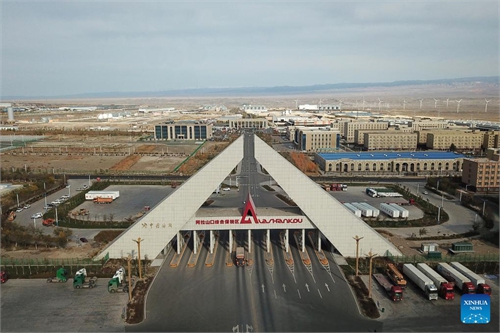A special train loaded with new-energy vehicles is ready to depart from the Xi’an International Inland Port on May 25, 2024. Photo: Liu Yang/GT
Among a series of fully loaded freight trains in the Xi’an International Inland Port, in Northwest China’s Shaanxi Province, one particularly prominent train stands out — a huge red double-decker train specialized for vehicle transportation. It is about to start a journey to Kazakhstan, carrying 261 domestic new-energy vehicles (NEVs).
The scene at the Xi’an inland port reflects closer economic and trade relations between China and Central Asian countries. Since the first China-Central Asia Summit was held in Xi’an last year, the inland port has been able to send five to eight new trains for NEVs per month, becoming a highlight in the increasingly deep trade ties between China and these five countries.
In 2023, trade volume between China and Central Asia reached $89.4 billion, a year-on-year increase of 27 percent. Shaanxi’s foreign trade with these countries totaled 5.79 billion yuan ($799.4 million), soaring 178 percent compared with the previous year. The province has become the frontier of China’s opening-up to Central Asia.
The Xi’an branch of China Railway Special Cargo Logistics Co has a huge “parking lot” at Xi’an International Inland Port, with a 250,000-square-meter operation area that can simultaneously park nearly 10,000 unlicensed new vehicles, some of which will soon be running on Central Asian soil.
“These vehicles will be transported to Horgos and other ports by special trains, and then sent to Central Asian countries and Russia,” said Cao Ping, head of the automobile logistics department of the logistics company, to the Global Times on Saturday.
Cao said that the business initially started last year and was only able to ship one to two trains per month. “This year we have made a qualitative leap, shipping thousands of NEVs every month,” Cao said, noting that Chinese sport-utility vehicles are the most popular products.
In addition to NEVs, demand for trucks and auto parts in Central Asia is also growing rapidly. Shaanxi Automobile Group, which mainly produces heavy trucks, exported more than 7,500 vehicles to Central Asian countries in 2023, up 110 percent year-on-year, according to data released by the company.
Shaanxi Konka Intelligent Home Appliances Co, the only intelligent kitchen appliance production base of Konka Group in Northwest China, has received overseas orders for over 10,000 dishwasher units this year, with the main export destinations including Germany, France, and Italy.
Currently, the company is exploring the market in five Central Asian countries, with washing machines already exported to Kazakhstan and preparations underway to export the first batch of dishwashers to Central Asia, Chen Zhao, general manager of the company, told the Global Times.
"Central Asia has more potential," Chen said, adding that more Kazakhstani merchants have zoomed into the Chinese market to book orders.
Wheatmeal from Kazakhstan Photo: Liu Yang/GT
Nursuru Zholbaskanova, CEO of the Russian logistics company SMARTLOG, is from Kazakhstan and was appointed by the headquarters in Moscow to open a branch in Xi’an in 2022. According to Zholbaskanova, the goods her company currently transports to China are mainly agricultural products such as barley, wheat, and millet.
“Our business is growing very fast, and the economic and trade ties between China, Central Asian countries, and Russia are getting closer,” she noted.
Liu Dongmeng, deputy general manager of Xi’an Aiju Grain and Oil Industrial Group, told the Global Times that the company’s trade volume with Central Asia has gradually increased, and the import category has expanded from grains and oils to all kinds of food products, thanks to the deepening of China-Central Asia cooperation as well as the smoothness of trade channels between the two sides. “This has helped diversify China’s food import routes and brought high-quality foreign products to Chinese consumers.”
“This cooperation is a win-win situation,” Liu said, noting that the company has not only invested in Kazakhstan but also brought Chinese equipment, technology, and management experience to the country.
Ice cream from Kazakhstan Photo: Liu Yang/GT


